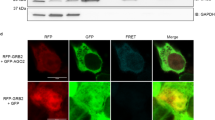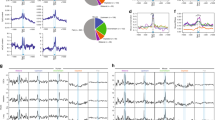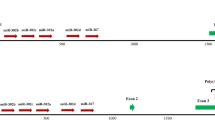Abstract
Processing of microRNAs (miRNAs) from their precursors to their biologically active mature forms is regulated during development and cancer. We show that mouse pri- or pre-miR-151 can bind to and compete with mature miR-151-5p and miR-151-3p for binding sites contained within the complementary regions of the E2f6 mRNA 3′ untranslated region (UTR). E2f6 mRNA levels were directly regulated by pri- or pre-miR-151. Conversely, miR-151–mediated repression of ARHGDIA mRNA was dependent on the level of mature miR-151 because only the mature miRNA binds the 3′ UTR. Thus, processing of miR-151 can have different effects on separate mRNA targets within a cell. A bioinformatics pipeline revealed additional candidate regions where precursor miRNAs can compete with their mature miRNA counterparts. We validated this experimentally for miR-124 and the SNAI2 3′ UTR. Hence, miRNA precursors can serve as post-transcriptional regulators of miRNA activity and are not mere biogenesis intermediates.
This is a preview of subscription content, access via your institution
Access options
Subscribe to this journal
Receive 12 print issues and online access
$189.00 per year
only $15.75 per issue
Buy this article
- Purchase on Springer Link
- Instant access to full article PDF
Prices may be subject to local taxes which are calculated during checkout






Similar content being viewed by others
Accession codes
References
Bushati, N. & Cohen, S.M. microRNA functions. Annu. Rev. Cell Dev. Biol. 23, 175–205 (2007).
Huntzinger, E. & Izaurralde, E. Gene silencing by microRNAs: contributions of translational repression and mRNA decay. Nat. Rev. Genet. 12, 99–110 (2011).
Bartel, D.P. MicroRNAs: genomics, biogenesis, mechanism, and function. Cell 116, 281–297 (2004).
Cullen, B.R. Transcription and processing of human microRNA precursors. Mol. Cell 16, 861–865 (2004).
Trujillo, R.D., Yue, S.B., Tang, Y., O'Gorman, W.E. & Chen, C.Z. The potential functions of primary microRNAs in target recognition and repression. EMBO J. 29, 3272–3285 (2010).
Okamura, K., Ladewig, E., Zhou, L. & Lai, E.C. Functional small RNAs are generated from select miRNA hairpin loops in flies and mammals. Genes Dev. 27, 778–792 (2013).
Obernosterer, G., Leuschner, P.J., Alenius, M. & Martinez, J. Post-transcriptional regulation of microRNA expression. RNA 12, 1161–1167 (2006).
Roush, S. & Slack, F.J. The let-7 family of microRNAs. Trends Cell Biol. 18, 505–516 (2008).
Thomson, J.M. et al. Extensive post-transcriptional regulation of microRNAs and its implications for cancer. Genes Dev. 20, 2202–2207 (2006).
Calin, G.A. et al. Frequent deletions and down-regulation of micro-RNA genes miR15 and miR16 at 13q14 in chronic lymphocytic leukemia. Proc. Natl. Acad. Sci. USA 99, 15524–15529 (2002).
Lee, E.J. et al. Systematic evaluation of microRNA processing patterns in tissues, cell lines, and tumors. RNA 14, 35–42 (2008).
De Vito, C. et al. A TARBP2-dependent miRNA expression profile underlies cancer stem cell properties and provides candidate therapeutic reagents in Ewing sarcoma. Cancer Cell 21, 807–821 (2012).
Davis, B.N. & Hata, A. Regulation of microRNA biogenesis: a miRiad of mechanisms. Cell Commun. Signal. 7, 18 (2009).
Treiber, T., Treiber, N. & Meister, G. Regulation of microRNA biogenesis and function. Thromb. Haemost. 107, 605–610 (2012).
Slezak-Prochazka, I., Durmus, S., Kroesen, B.J. & van den Berg, A. MicroRNAs, macrocontrol: regulation of miRNA processing. RNA 16, 1087–1095 (2010).
Newman, M.A. & Hammond, S.M. Emerging paradigms of regulated microRNA processing. Genes Dev. 24, 1086–1092 (2010).
Bass, B.L. RNA editing by adenosine deaminases that act on RNA. Annu. Rev. Biochem. 71, 817–846 (2002).
Heale, B.S., Keegan, L.P. & O'Connell, M.A. The effect of RNA editing and ADARs on miRNA biogenesis and function. Adv. Exp. Med. Biol. 700, 76–84 (2010).
Yang, W. et al. Modulation of microRNA processing and expression through RNA editing by ADAR deaminases. Nat. Struct. Mol. Biol. 13, 13–21 (2006).
Iizasa, H. et al. Editing of Epstein-Barr virus-encoded BART6 microRNAs controls their dicer targeting and consequently affects viral latency. J. Biol. Chem. 285, 33358–33370 (2010).
Kawahara, Y., Zinshteyn, B., Chendrimada, T.P., Shiekhattar, R. & Nishikura, K. RNA editing of the microRNA-151 precursor blocks cleavage by the Dicer–TRBP complex. EMBO Rep. 8, 763–769 (2007).
Kawahara, Y. et al. Redirection of silencing targets by adenosine-to-inosine editing of miRNAs. Science 315, 1137–1140 (2007).
Memczak, S. et al. Circular RNAs are a large class of animal RNAs with regulatory potency. Nature 495, 333–338 (2013).
Poliseno, L. et al. A coding-independent function of gene and pseudogene mRNAs regulates tumour biology. Nature 465, 1033–1038 (2010).
Tay, Y. et al. Coding-independent regulation of the tumor suppressor PTEN by competing endogenous mRNAs. Cell 147, 344–357 (2011).
Cesana, M. et al. A long noncoding RNA controls muscle differentiation by functioning as a competing endogenous RNA. Cell 147, 358–369 (2011).
Franco-Zorrilla, J.M. et al. Target mimicry provides a new mechanism for regulation of microRNA activity. Nat. Genet. 39, 1033–1037 (2007).
Hansen, T.B. et al. Natural RNA circles function as efficient microRNA sponges. Nature 495, 384–388 (2013).
Smalheiser, N.R. & Torvik, V.I. Mammalian microRNAs derived from genomic repeats. Trends Genet. 21, 322–326 (2005).
Shin, C. et al. Expanding the microRNA targeting code: functional sites with centered pairing. Mol. Cell 38, 789–802 (2010).
Cartwright, P., Muller, H., Wagener, C., Holm, K. & Helin, K. E2F-6: a novel member of the E2F family is an inhibitor of E2F-dependent transcription. Oncogene 17, 611–623 (1998).
Gu, S., Jin, L., Zhang, F., Sarnow, P. & Kay, M.A. Biological basis for restriction of microRNA targets to the 3′ untranslated region in mammalian mRNAs. Nat. Struct. Mol. Biol. 16, 144–150 (2009).
Liu, J. et al. Argonaute2 is the catalytic engine of mammalian RNAi. Science 305, 1437–1441 (2004).
Diederichs, S. & Haber, D.A. Dual role for argonautes in microRNA processing and posttranscriptional regulation of microRNA expression. Cell 131, 1097–1108 (2007).
Ding, J. et al. Gain of miR-151 on chromosome 8q24.3 facilitates tumour cell migration and spreading through downregulating RhoGDIA. Nat. Cell Biol. 12, 390–399 (2010).
Rehmsmeier, M., Steffen, P., Hochsmann, M. & Giegerich, R. Fast and effective prediction of microRNA/target duplexes. RNA 10, 1507–1517 (2004).
Chu, C., Qu, K., Zhong, F.L., Artandi, S.E. & Chang, H.Y. Genomic maps of long noncoding RNA occupancy reveal principles of RNA-chromatin interactions. Mol. Cell 44, 667–678 (2011).
Giangrande, P.H. et al. A role for E2F6 in distinguishing G1/S- and G2/M-specific transcription. Genes Dev. 18, 2941–2951 (2004).
Hsu, S.D. et al. miRTarBase: a database curates experimentally validated microRNA-target interactions. Nucleic Acids Res. 39, D163–D169 (2011).
Alves, C.C., Carneiro, F., Hoefler, H. & Becker, K.F. Role of the epithelial-mesenchymal transition regulator Slug in primary human cancers. Front. Biosci (Landmark Ed) 14, 3035–3050 (2009).
Peng, X. & Guan, J.L. Focal adhesion kinase: from in vitro studies to functional analyses in vivo. Curr. Protein Pept. Sci. 12, 52–67 (2011).
McLean, G.W. et al. The role of focal-adhesion kinase in cancer: a new therapeutic opportunity. Nat. Rev. Cancer 5, 505–515 (2005).
Kumar, M.S., Lu, J., Mercer, K.L., Golub, T.R. & Jacks, T. Impaired microRNA processing enhances cellular transformation and tumorigenesis. Nat. Genet. 39, 673–677 (2007).
Chen, J.F. et al. The role of microRNA-1 and microRNA-133 in skeletal muscle proliferation and differentiation. Nat. Genet. 38, 228–233 (2006).
Schmittgen, T.D., Jiang, J., Liu, Q. & Yang, L. A high-throughput method to monitor the expression of microRNA precursors. Nucleic Acids Res. 32, e43 (2004).
Kurreck, J., Wyszko, E., Gillen, C. & Erdmann, V.A. Design of antisense oligonucleotides stabilized by locked nucleic acids. Nucleic Acids Res. 30, 1911–1918 (2002).
Christoffersen, N.R. et al. p53-independent upregulation of miR-34a during oncogene-induced senescence represses MYC. Cell Death Differ. 17, 236–245 (2010).
Acknowledgements
We thank members of the Kay laboratory, in particular, L. Lisowski for help with fluorescence-activated cell sorting, F. Zhang for mouse dissection and culture of Dicer-knockout cells, L. Sobkowiak for RNA extraction from mouse tissues and S. Gu and H.K. Kim for critical comments and helpful discussion. We also thank J. Sage and T. Rando (both at Stanford University) for providing reagents and A. Lund (University of Copenhagen) for advice on the biotinylated pre-miR-151 pulldown assay. We obtained the catalytically inactive form of Ago2 (Ago2-D597A) as a kind gift from G. Hannon (Cold Spring Harbor Laboratory). This work was supported by the US National Institutes of Health (grant DK078424 to M.A.K.). P.N.V. is supported by a Banting Postdoctoral Fellowship from the Canadian Institutes of Health Research.
Author information
Authors and Affiliations
Contributions
B.R.-C., P.N.V. and M.A.K. designed the experiments. B.R.-C. performed the experiments with the exception of the ChIRP experiments, which were performed by Q.W. and Q.-J.L. Y.Z. performed bioinformatic predictions; B.R.-C., P.N.V. and M.A.K. analyzed and discussed the results and wrote the paper.
Corresponding author
Ethics declarations
Competing interests
The authors declare no competing financial interests.
Integrated supplementary information
Supplementary Figure 1 Overexpression and processing of miRNAs from plasmids.
Sequences of the mature mouse miRNAs are indicated in bold. (a) Northern blot analysis of miR-151-5p and miR-151-3p overexpressed specifically from their respective U6 promoter driven small hairpin (sh) constructs. (b) Northern blot analysis of miR-124 overexpressed from a sh construct. (c) Northern blot analysis of miR-124 overexpressed from a Pol II based CMV driven construct, pEZX-124.
Supplementary Figure 2 Pre-miR-151 antagonizes mature miR-151 binding to E2f6 3′UTR.
(a) Multiple alignments of the binding site of the pre-miR-151 within the E2F6 3′UTR region (top panel) and pre-miR-151 (bottom panel) across various species. The pre-miR-151 is color coded to show the 5p arm (brown) and the 3p arm (green). (b) Schematic of the base pairing of the A-to-I edited pre-miR-151 with the mouse E2f6 3′UTR. Positions of the two inosines are shown in purple. The additional A:I base pairing created by editing is indicated by a dot. (c) Northern blot analysis of miR-151 from the Pol II based pEZX-151 construct. The blot was probed with a LNA probe against miR-151-5p. (d) Dual-luciferase reporter assay with E2f6 3′UTR (WT), 3p del or 3p-5p swap constructs and Sh-151-5p or Sh-151-3p. (e) Dose-dependent dual-luciferase reporter assay with E2f6 3′UTR WT and modified targets in presence of increasing dose of only mature miR-151-5p (Sh-151-5p) or both pre-miR-151 and mature miR-151-5p (pEZX-151 or pEZX-DM). (f) Dual luciferase reporter assay with E2f6 3′UTR in presence of Sh or pEZX-constructs and DNA/LNA mixmer blocker complimentary to the site of E2f6 where miR-151-3p binds. (g) Northern analysis of processing of pre-miR-151 in Dicer knockout cells. For comparison, processing of pre-miR-151 from MEF cells is also shown. U6 serves as a loading control. (h) Dual luciferase reporter assay with E2f6 3′UTR in presence of a synthetic duplex miR-151 and increasing amounts of the (A to G substituted) form of pre-miR-151 (pEZX-DM) in Dicer KO cells Normalization was done with respect to duplex synthetic miR-122. As a control, pEZX-124 was used as shown. (d — f, h) For reporter assays, error bars, s.e.m. (n = 2 biological replicates, each with 4 technical replicates).
Supplementary Figure 3 miR-151-3p–binding site in E2f6 3′ UTR is not antagonistic or does not interfere with miR-151-5p binding to its site.
(a) Dual-luciferase reporter assay for E2f6 3′UTR construct in presence of increasing proportion of Sh-151-5p relative to either a dose of Sh-151-3p or a control Sh-S. (b) Dual-luciferase assay reporter assay for E2f6 3′UTR or E2f6-3p del (E2f6 3′UTR lacking miR-151-3p binding site) construct in presence of increasing dosage of Sh-151-5p. In each transfection, a fixed amount of Sh-151-3p is also transfected. (a, b) For reporter assays, error bars, s.e.m. (n = 2 biological replicates, each with 4 technical replicates).
Supplementary Figure 4 Pre-miR-151 binds to E2f6 3′ UTR in vitro.
Quantitative PCR analysis of E2f6 from a streptavidin pull-down of a biotinylated 4tU-containing synthetic pre-miR-151 RNA (I) oligo. Error bars, s.e.m. (n = 2 biological replicates, each with 3 technical replicates).
Supplementary Figure 5 Predicted widespread gene regulation by pre-miRNAs in competition with mature miRNAs for the same target.
(a) A flowchart of the bioinformatics pipeline to predict genome-wide interactions of the precursor miRNAs with their predicted target 3′UTR regions common to human and mouse that would overlap with the binding of their corresponding mature miRNA forms. (b) Dual-luciferase reporter assay for wild-type SNAI2 3′UTR or its modified forms (SNAI2 ran or SNAI2 swap) in presence of mature miR-124 (Sh-124). Error bars, s.e.m. (n = 2 biological replicates, each with 4 technical replicates).
Supplementary information
Supplementary Text and Figures
Supplementary Figures 1–6 and Supplementary Tables 2 and 4–6 (PDF 1405 kb)
Supplementary Table 1
Genome-wide predictions of competitions between mature miRNAs and their precursors to bind to overlapping targets (XLSX 233 kb)
Supplementary Table 3
List of targets predicted to be regulated by precursors of repeat encoded miRNAs, miR-28 and miR-340, in humans (XLSX 127 kb)
Rights and permissions
About this article
Cite this article
Roy-Chaudhuri, B., Valdmanis, P., Zhang, Y. et al. Regulation of microRNA-mediated gene silencing by microRNA precursors. Nat Struct Mol Biol 21, 825–832 (2014). https://doi.org/10.1038/nsmb.2862
Received:
Accepted:
Published:
Issue Date:
DOI: https://doi.org/10.1038/nsmb.2862



